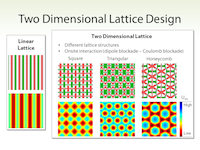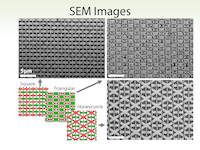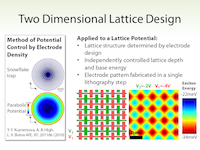Measurement of exciton correlations using electrostatic lattices |
|

|
We present a method for determining correlations in a gas of indirect excitons in a semiconductor quantum well structure. The method involves subjecting the excitons to a periodic electrostatic potential that causes modulations of the exciton density and photoluminescence (PL). Experimentally measured amplitudes of energy and intensity modulations of exciton PL serve as an input to a theoretical estimate of the exciton correlation parameter and temperature. We also present a proof-of-principle demonstration of the method for determining the correlation parameter and discuss how its accuracy can be improved. M. Remeika, J. R. Leonard, C. J. Dorow, M. M. Fogler, L. V. Butov, M. Hanson, and A. C. Gossard, Measurement of exciton correlations using electrostatic lattices, arXiv:1508.04407v1 (2015), Phys. Rev. B 92, 115311 (2015). |
Excitons in 2D Electrostatic Lattices |
|


|
We report on a method for the realization of two-dimensional electrostatic lattices for excitons using
patterned interdigitated electrodes. Lattice structure is set by the electrode pattern and depth of the
lattice potential is controlled by applied voltages. We demonstrate square, hexagonal, and honeycomb
lattices created by this method.
M. Remeika, M. M. Fogler, L. V. Butov, M. Hanson, and A. C. Gossard, Two-dimensional electrostatic lattices for indirect excitons, arXiv:1109.6659v1 (2011), Appl. Phys. Lett. 100, 061103 (2012). M. Remeika, L.V. Butov, M.M. Fogler, M. Hanson, A.C. Gossard, Excitons in Electrostatic Lattices, CLEO/QELS, May 7-11, 2012, San Jose, CA. M. Remeika, L.V. Butov, M. Hanson, and A.C. Gossard, Excitons in Electrostatic Lattices, APS March Meeting, March 21-25, 2011, Dallas, TX. |
Excitons in Electrostatic Lattices |
|


|
We study transport of indirect excitons in GaAs/AlGaAs coupled quantum wells in linear lattices
created by laterally modulated gate voltage. The localization-delocalization transition for
transport across the lattice was observed with reducing lattice amplitude or increasing exciton
density. The exciton interaction energy at the transition is close to the lattice amplitude.
These results are consistent with the model, which attributes the localization-delocalization
transition to the interaction-induced percolation of the exciton gas through the external potential.
M. Remeika, J. C. Graves, A. T. Hammack, A. D. Meyertholen, M. M. Fogler, L. V. Butov, M. Hanson, and A. C. Gossard, Localization-Delocalization Transition of Indirect Excitons in Lateral Electrostatic Lattices, arXiv:0901.1349v1 (2009); Phys. Rev. Lett. 102, 186803 (2009). |


